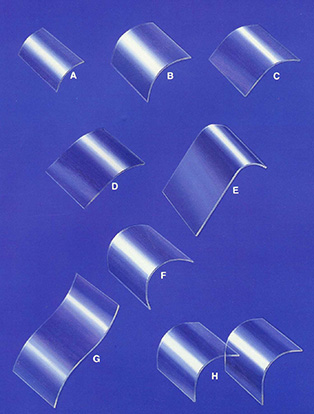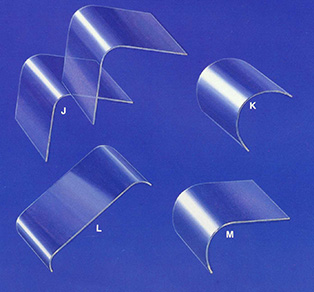
- Type A:
Shallow cylindrical bend; arc not to exceed 58 degrees - Type B:
Cylindrical bend; arc exceeds 58 degrees but not 90 degrees - Type C:
Curve-plus-tangent with curve limited to 60 degrees. Tangent may not constitute more than 1/3 of the total girth

- Type D:
Curve-plus-tangent with curve not exceeding 38-1/2 degrees of arc. Tangent may not exceed the arc - Type E:
Curve-plus-tangent type has a tangent not more than twice the curve and curved portion not exceeding 90 degrees of arc - Type F:
Curve exceeds 90 degrees but not 128 degrees - Type G:
Non-circular curve. Shape is that of a shallow letter “S” - Type H:
Central curve flanked by tangents which may be equal or unequal. The curve may not exceed 90 degrees, and both tangents together in length may not exceed 1/4 the total girth - Type J:
Tangent-plus-arc-plus-tangent; curve 90 degrees or less, the tangents together, equal or unequal, not to exceed 3/4 of the total girth - Type K:
Curve exceeds 128 degrees but not 180 degrees - Type L:
Two curves of like radius and each not exceeding 90 degrees with a common tangent between them - Type M:
Deep-curve-plus-tangent; curve will exceed 90 degrees of the arc - Types of Edgework:
Seamed, pencil ground, pencil polished, flat ground with chamfer, flat polished with chamfer.
Curving Capabilities:
ProCurve Glass Design, Inc. also provides a variety of glass options including uncoated clear or tinted, pyrolitic reflective and low E, spandrel, wire and patterned glasses as well as special edgework and polishing. Technical assistance is always available to assist you during the design phase of your project.
Chemically Strengthened Glass:
ProCurve Glass Design, Inc. can provide additional strength to glass lites through a chemical strengthening process known as ion-exchange. The glass is submerged in a bath of potassium nitrate where the large alkali potassium ions exchange places with the smaller alkali sodium ions in the surface of the glass. Because chemically strengthened glass breaks in a pattern similar to annealed glass, it is not used by itself as a safety glazing material. It can be laminated for a variety of security, and transportation applications.
